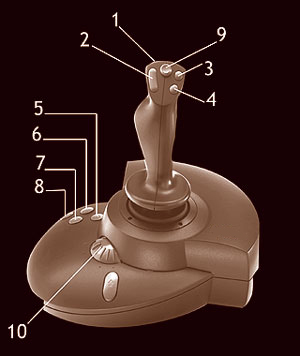Related
Links
|
||||||||||||||
Flight Simulator is most realistic when you use a joystick, yoke, or other controller. You can fly more precisely, and the buttons and controls make it easy to change views, adjust the throttle, extend or retract the landing gear and flaps, and operate other aircraft controls.
Flight Simulator is compatible with joysticks, yokes, game pads, and other controllers supported by Microsoft Windows and the DirectInput device standard. Use the device that works best for you as your primary control, and customize it to suit your needs. Many products feature different configurations, so refer to your controller's documentation for its button assignments.
Before you fly, make sure your joystick or other controller is:
- Plugged into your computer.
- Enabled in Microsoft Windows Control Panel.
- Calibrated properly (see Calibrating Your Joystick).
Also make sure you have the latest device drivers. If in doubt, download and install them from the manufacturer's Web site.
|
Extreme Control To make your Flight Simulator experience even more realistic, consider adding yokes, rudder pedals, throttle quadrants, and radio stacks. To learn more, see Expanding Your Hobby. |
Joystick Commands
Depending on your joystick, you'll probably have buttons for frequently used controls and for cockpit views, but you'll still need to use the mouse or keyboard for other functions.
 1. (Trigger) release brakes 2. Cycle views 3. Elevator trim down 4. Elevator trim up 5. Extend flaps 6. Retract flaps 7. Drop objects 8. Landing gear up/down 9. (Hat switch) Look around 10. Throttle control |
Here's a list of the default joystick commands:
| Action | Command |
| Apply/release brakes | Button 1 (trigger) |
| Cycle views (Cockpit, Tower, Track, Spot) | Button 2 |
| Elevator trim down | Button 3 |
| Elevator trim up | Button 4 |
| Extend flaps | Button 5 |
| Retract flaps | Button 6 |
| Drop objects | Button 7 |
| Landing gear up/down | Button 8 |
| Bank left (ailerons) | Move stick left |
| Bank right (ailerons) | Move stick right |
| Pitch down (elevator) | Move stick forward |
| Pitch up (elevator) | Move stick backward |
| Yaw left (rudder) | Twist stick left |
| Yaw right (rudder) | Twist stick right |
| Look ahead/right | Move hat switch up/right |
| Look right | Move hat switch right |
| Look back/right | Move hat switch down/right |
| Look back | Move hat switch down |
| Look back/left | Move hat switch down/left |
| Look left | Move hat switch left |
| Look ahead/left | Move hat switch up/left |
| Look up | Move hat switch up |
Customizing Joystick Assignments
Change the control assignments to customize the joystick use to suit your flying style.
|
To change joystick button commands
|
|
To change joystick axes
|
|
Resetting and Deleting Assignments To remove a control assignment from a command you've selected, click the Delete Assignment button on the Buttons/Keys or Joystick Axes tab. To cancel any changes you've made to your controller assignments and return to the Flight Simulator default settings, click the Reset Defaults button. |
Calibrating Your Joystick
If your joystick seems to be behaving erratically, you may need to calibrate it.
 You can calibrate your joystick in the Windows Game Controllers dialog box |
|
To calibrate your joystick
|
Adjusting Joystick Sensitivity
Flight Simulator's preset sensitivity for joysticks is in the middle of the range, and the response rate is average. You can adjust these sensitivities; experiment to find the setting you like best.
"Sensitivity" refers to how sensitive the joystick is for a given axis. For example, with high sensitivity, the slightest movement of the joystick will have a large effect on the aircraft's controls in Flight Simulator.
"Null Zone" refers to how much "dead space" there is in a given joystick axis center position. For example, with a large null zone, you will be able to move the joystick slightly before it has an effect on the aircraft's controls in Flight Simulator.
|
To adjust the sensitivity of your joystick
|
Note
To reset all sensitivity options to their default
values, click the Reset Defaults button.
Adjusting Joystick Forces
If you are using a force-feedback joystick, you can enable or disable any or all force-feedback options:
- Control surfaces: When moving the rudder, elevator, and ailerons, you'll feel control surface forces.
- Stick shaker: If you exceed the maximum speed in a jet, the controller will shake.
- Crashes: If you crash, you'll feel it in the controller.
- Ground surfaces: As you roll across the ramp, taxiway, and runway, you'll feel the bumps through the controller.
- Retractable landing gear: When you retract the landing gear, you'll feel it through the controller.
 If you have a force-feedback joystick, you can adjust the forces in the Controls Forces dialog box |
|
To adjust joystick forces
|
Note
To disable all force feedback options, clear the
Enable force feedback checkbox on the
Forces tab.